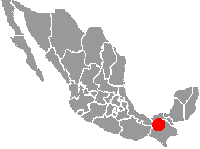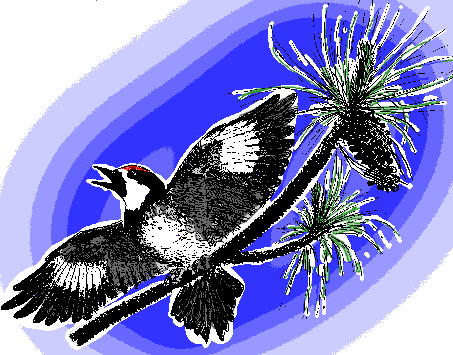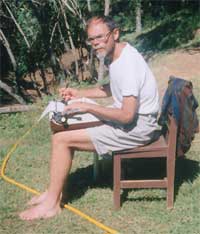YERBA BUENA CLINIC
December 6, 1996
Notes from a birding trip through Mexico by Jim Conrad
 From Palenque I take buses
to the state capital Tuxtla Gutiérrez, then, hoping to escape the rain, I head into the
uplands, to the tourist town of San Cristóbal de Las Casas. There I spend two or three
days, but the rain is heavy there, too, so I leave with little to report but mud.
From Palenque I take buses
to the state capital Tuxtla Gutiérrez, then, hoping to escape the rain, I head into the
uplands, to the tourist town of San Cristóbal de Las Casas. There I spend two or three
days, but the rain is heavy there, too, so I leave with little to report but mud.
The circumstance is that during the course of this birding trip I have decided to abandon my life based for the last couple of years in the little French-speaking town of Nivelles, Belgium. I am trying to get permission to become a hermit living in an isolated part of the extensive forest of a friend's large plantation in southwestern Mississippi, but so far nothing is sure about that. At this moment really I have no place fixed to go and am simply tired of traveling.
The new destination is Yerba Buena Clinic just a kilometer or so north of the highland Indian town of Pueblo Nuevo Solistahuacan. I have a long history with Yerba Buena, having published a book about it. The clinic provides free or inexpensive service to the area's impoverished Tzotzil-speaking Indians and is operated by Seventh Day Adventist missionaries. I had no interest in supporting missionary work but I wanted to support the clinic with income from the book.
The narrow, paved road to Yerba Buena is so twisty that I always get motion-sick going there, and this time is no exception. I arrive late one afternoon sick as a dog and with a storm threatening. Though I'm received with the usual courtesy shown any stranger, no one here remembers me from the months I spent writing the book. I'm allowed to throw my tent beneath a shed's tin roof, and this is quite an upgrade from recent weeks.
The next day members of the missionary family arrive and they know me very well. They make me feel very welcome indeed. They say I can have a room in the compound and stay as long as I wish. I offer to work in the garden and do odd jobs. I couldn't have hoped for anything more perfect. I end up happily staying until the last week in January, 1997, when I move to Mississippi and become a hermit.
"BORDERLINE CLOUD-FOREST"
Many years ago I came into these parts looking for interesting habitats with new species of plants and animals. The forest here is mainly oak and pine, but the elevation is around 1800 meters (5940 feet) and the nearby peaks are so often shrouded in clouds that "borderline cloud-forest" exists. At the peaks, trees are small and very gnarly, and their limbs as well as the ground around them are carpeted with thick, spongy, wet communities of moss, lichen, fungus, orchids, bromeliads, peperomias and more.
The clinic owns the land above them, all the way to the peak, and attempts are made to keep the forest intact to protect the water supply. Lately much of the forest has been destroyed by "invaders," local militant Indians who clear the land for themselves and grow corn there. Still, this is some of the most intact vegetation for many kilometers around.
During the last Ice Age, northern biological communities shifted far to the south. When the ice retreated, some plants and animals migrated back north, but others migrated upslope, always staying within the cool zone they preferred. Therefore today you can find isolated mountaintop islands of plant communities in which there are species typical of forests far to the north. Some of these species have evolved into different subspecies and even new species, but others appear to be identical, or almost identical, to their northern ancestors.
For example, in Yerba Buena's oak-pine forest, in which the oaks and pines are southern Mexican species, there are such Eastern North American trees as Sweetgum (Liquidamber styraciflua), Blackgum (Nyssa sylvatica), Eastern Hophornbeam (Ostrya virginiana var. guatamalensis) and a dogwood,Cornus disciflora, that's become a different species, but is very clearly closely related to a North American dogwood. For more information on the plants and animals of the Yerba Buena area you can consult the publication called University of East Anglia Mexico Expedition 1987. East Anglia is in the UK. I don't think the paper was published, but a number of copies were bound and distributed.
MIXED-UP SEASONS
On my first day back at Yerba Buena I walk around trying to get a fix on what the season is. By early December the dry season should have begun but the herbage is still lush and green, and roadside weeds, blackberry canes and grapevines are still issuing robust, green sprouts as if it were early summer up north. It doesn't feel like early summer, though, because the high-elevation sunlight is crystalline-sharp. The morning smells like early summer -- crushed herbage, the faint scent of mud and old sweat -- but some of the Sweetgums' leaves are bright red, curling up and falling as if it were the droughty end of fall. Other Sweetgums are as green as a gringo Sweetgum in July. The peach trees express the season all by themselves: At the ends of their black limbs, red-spotted, green leaves cluster in late-summer mode, but along their limbs pale pink blossoms announce the arrival of spring.
The birds don't seem to notice any out-of-whack feeling, though. A Black-headed Siskin lights on a Sweetgum ball and pulls out seeds just as if it were a Goldfinch farther north. A Wilson's Warbler eats a tiny butterfly, first the body disappearing down the gullet, then the folded wings following.
THE LAST BIRDLIST
While at Yerba Buena I make many walks and compile several lists. Only on one day though, my second day there do I make a somewhat serious effort to get a good list, and that's the one given below.
MEXICO: Chiapas; Secondary oak/pine forest, borderline cloud forest, roadside, weedy areas, in and around Yerba Buena Clinic 1 km north of Pueblo Nuevo Solistahuacan, elevation ±1800 m (5,900 feet).
permanent resident
winter resident
not found in the USA
- Black Vulture
- Turkey Vulture
- Squirrel Cuckoo
- Black-crested Coquette
- White-eared Hummingbird
- Mountain Trogon
- Acorn Woodpecker
- Hairy Woodpecker
- Northern Flicker
- Yellow-bellied Sapsucker
- Spot-crowned Woodcreeper
- Barred Antshrike
- Greater Pewee
- Tufted Flycatcher
- Green Jay
- Band-backed Wren
- House Wren
- Plain Wren
- Gray Catbird
- Rufous-collared Robin
- Brown-backed Solitaire
- Eastern Bluebird
- Cinnamon Flower-piercer
- Solitary Vireo
- Black-and-white Warbler
- Black-throated Green Warbler
- Hermit Warbler
- MacGillivray's Warbler
- Nashville Warbler
- Red-faced Warbler
- Rufous-capped Warbler
- Townsend's Warbler
- Wilson's Warbler
- Painted Redstart
- Great-tailed Grackle
- Blue-hooded Euphonia
- Hepatic Tanager
- White-naped Brush-finch
- Black-headed Siskin
- Rufous-collared Sparrow
- Rusty Sparrow
BROWN-BACKED SOLITAIRE AT DAWN
From daybreak until around 8 AM while making the above list, the Brown-backed Solitaire produced a nearly continuous outpouring of its bubbling, echoic, glorious call. My Peterson Field Guide describes the call as suggesting the "cranking up of an old-time motor car; it starts off with wenk, wenk, then catches and takes off at a fast pace with flutelike notes, etc." When the singing finally ends, the landscape suddenly feels empty and less dramatic and meaningful than just moments before. The Brown-backed Solitaire defines this land.
CIOAC
The seasons are out of whack and life in these mountains also is out of whack. One morning I walk into Pueblo Nuevo for a hot meal of beans and scrambled eggs a la mejicana. I take a seat at the only table in a hut with a ceiling so low I must bend. The structure is open on the street side and the street is a pure quagmire of mud. While I eat, a couple arrive, the man riding a burro and his wife dressed in Indian style, barefoot, walking and carrying goods to sell on her head. They enter the restaurant and sit across from me. The man orders a meal for himself. The wife sits next to him facing him, thus holding her body at a right angle to me, never once looking at me, and she eats nothing, simply watches him eat, belch, and pick his teeth as he stares at me. She looks very embarrassed, and also very tense and scared. Her face is as intelligent as his is aggressive and impudent. He knows I speak Spanish and that I'm interested in talking, but he just stares at me, saying nothing.
The highway crosses Yerba Buena's property. On the upslope side which the clinic is trying to preserve forested for the water supply, there's an old sign in Spanish asking people to not pick the flowers or cut firewood. This has been painted over with the letters CIOAC, the name of the local group of poor people organizing to seize properties by force. On the cistern upslope someone has scrawled "Tomado por CIOAC" -- "Taken by CIOAC."
On Christmas Eve there's a great deal of drinking among the men in town and late in the day a large, angry group comes to the entrance road, but are talked out of entering the compound. People in these parts believe that there's a law that if someone finds unused land or an empty house they have a right to take possession of it, so I spend Christmas Eve sleeping in one of the clinic's isolated houses, hoping to not be "invaded." Happily, on Christmas Day, things are quiet and nothing has happened.
Population density in this land is simply too high for the resources available, so even in a community that for decades has received free or very inexpensive medical service, large numbers of people are turning against those who earlier helped them. Nothing is sacred when population density outstrips the ability of a habitat to sustain life.

 At last my invitation to move into the forest of
southwestern Mississippi to live as a hermit arrives, and among my reasons to go there are
that I plan to focus with few distractions on mastering the Internet. Perhaps via the
Internet I may be able to somehow ameliorate the coming ecological disaster. I don't know
how I'll do this, but I do know that I must try.
At last my invitation to move into the forest of
southwestern Mississippi to live as a hermit arrives, and among my reasons to go there are
that I plan to focus with few distractions on mastering the Internet. Perhaps via the
Internet I may be able to somehow ameliorate the coming ecological disaster. I don't know
how I'll do this, but I do know that I must try.